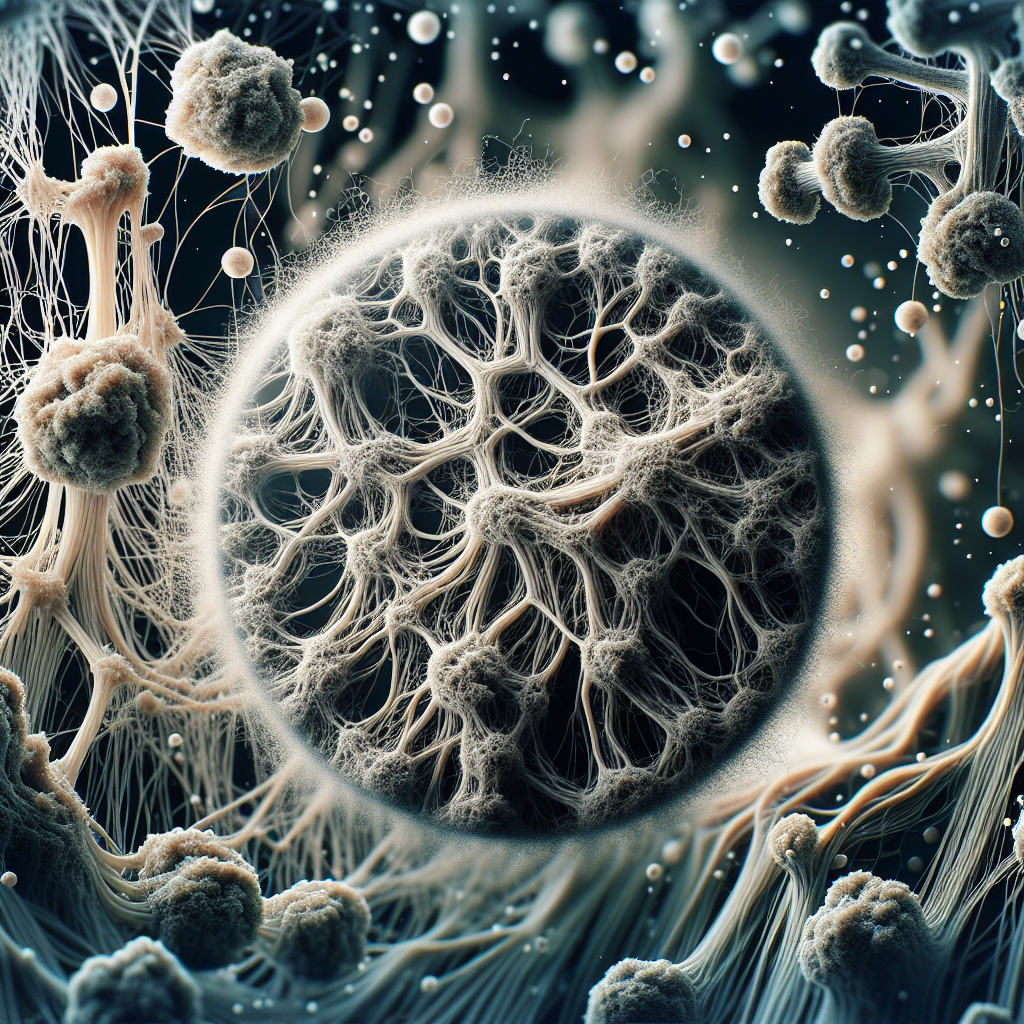In the radically emerging field of biotechnology, a significant role is being played by a naturally occurring network of fungal threads known as Mycelium. As you venture through the article, “Understanding How Mycelium Might Revolutionize Industry,” you will explore the transformative potential that this incubatory root structure holds for various industries. Not restricted to its foundational role in our ecosystem, Mycelium demonstrates a spectrum of applications ranging from sustainable packaging solutions to construction. It’s the bedrock of tomorrow’s green economy – offering a unique blend of sustainability, efficiency, and innovation. Prepare yourself for a fascinating journey into the intricate world of Mycelium, and imagine the surge of possibilities that this miraculous element might unlock for the future.
Understanding Mycelium
Defining Mycelium
Mycelium refers to the vegetative part of a fungus that consists of a mass of branching, thread-like hyphae. Although you may not see it because it is often hidden beneath the soil or within decaying plant material, mycelium plays a crucial role in the lifecycle of fungi and the ecosystems where they reside.
Natural Characteristics of Mycelium
Characteristically, mycelium exhibits a cotton-like structure that is usually white but can vary in color. Its intertwined hyphae form dense networks that can spread expansively, growing whenever conditions are right to decompose organic matter. Mycelium is also responsible for absorbing nutrients from the environment, enabling the organism to grow and reproduce.
The Lifecycle of Mycelium
The lifecycle of Mycelium begins when spores, analogous to the seeds of a plant, land on a substrate that provides suitable nutrients. These spores then germinate, giving rise to hyphae, which collectively form the mycelium. Over time, if the necessary environmental conditions are met, certain parts of the mycelium may differentiate and form structures that will eventually produce new spores, thus completing the lifecycle and allowing for the continuation of the species.
Mycelium in Nature and Ecosystems
Mycelium’s role in the Environment
In the environment, mycelium acts as nature’s recycler. Through its dense networks, it breaks down dead and decaying organic material, transforming it into nutrients that can then be absorbed by plants. This natural recycling process plays an integral role in maintaining the health and sustainability of ecosystems around the world.
How Mycelium Contributes to Soil Health
By recycling organic material, mycelium enriches the soil with nutrients, thereby enhancing its fertility. Additionally, their network-like structures foster soil aggregation, which improves soil structure and water-holding capacity. This ability to improve soil health makes mycelium valuable to both natural ecosystems and agricultural fields.
Interactions between Mycelium and other Organisms
Mycelium forms symbiotic relationships with numerous plants and other organisms. For instance, through mycorrhizal associations, mycelium exchanges nutrients with the roots of plants, aiding their growth and health. Mycelium also interacts with bacteria and other microorganisms, often in complex ways that influence the health and function of the broader ecosystem.

Exploring the Potential of Mycelium in Industry
Historical uses of Mycelium
Historically, mycelium has found a variety of applications across industries. One traditional utilization is its role in the production of certain types of fermented foods and beverages, including bread, beer, and cheese, where it contributes to both the flavor and texture of these products.
Recent Developments in Mycelium Applications
In recent years, advancements in biotechnology have opened new avenues for mycelium applications. Its unique properties are being leveraged in various industries, from sustainable packaging to textile production and beyond. For instance, mycelium is now being used to create eco-friendly alternatives to plastic and leather, tapping into its inherent biodegradability and adaptability.
Potential Industries for Mycelium Usage
Potential industrial applications for mycelium abound. As noted, it has already established a presence in packaging, textiles, and food industries, but it also holds promise for other sectors. For instance, in construction, mycelium’s structural properties are being explored for its potential use as a sustainable building material. Similarly, within the healthcare and pharmaceutical industries, there is ongoing research into the medicinal properties of mycelium.
Mycelium and Sustainable Development
How Mycelium can Help in Waste Management
Mycelium’s ability to digest and transform organic waste makes it a valuable ally in waste management efforts. Its potential to break down complex organic materials, such as certain types of plastic, could be employed to help address the global waste crisis. Moreover, biodegradable products made from mycelium, such as packaging materials, can significantly reduce waste by decomposing naturally and enriching the soil in the process.
Mycelium’s Contribution to Reducing Carbon Footprint
Through its role in the natural carbon cycle, mycelium can help sequester carbon dioxide, one of the major greenhouse gases contributing to climate change. By using mycelium-based materials in industries such as construction and packaging, we can contribute to reducing CO2 emissions, thereby helping to mitigate global warming.
Impact of Mycelium on Sustainable Agriculture
The symbiotic relationships that mycelium forms with plants, along with its ability to enhance soil health, can be harnessed to promote sustainable agriculture. Farmers can leverage mycelium to improve crop yields, reduce the need for synthetic fertilizers, and promote the overall health of their agricultural ecosystems.

Commercializing Mycelium-Based Products
Market Potential for Mycelium Products
With increasing awareness about the environmental costs of conventional materials like plastic, leather, and concrete, there’s a growing market for sustainable alternatives. Mycelium-based products perfectly fit the bill and offer ample business opportunities across various sectors including construction, textiles, packaging, food and beverage, and more.
Challenges in the Commercialization of Mycelium
Despite the significant potential, the commercialization of mycelium-based products faces several challenges. The scaling-up of production is an area of concern, as the cost and complexity of mass-producing such products are substantial. Also, as with any biological product, maintaining quality and consistency can be challenging. More research and development is needed to address these issues to promote wider acceptance and uptake of mycelium products.
Consumer Perception and Acceptance of Mycelium Products
Understanding and promoting consumer acceptance is vital for the commercial success of mycelium-based products. The use of fungal material in everyday products might initially raise eyebrows among consumers. However, providing education about the environmental benefits and, in some cases, superior performance of these products can aid in altering consumer perception and encouraging wider acceptance.
Mycelium in the Construction Industry
Experimentation with Mycelium as a Building Material
Experimentation with mycelium as a building material has been ongoing in the construction industry. Because mycelium binds together organic materials, it has the potential to create strong, lightweight, and insulating building materials. Moreover, these mycelium-based materials are sustainable, biodegradable, and low-cost compared to conventional building materials.
Benefits and Challenges of Mycelium in Construction
Mycelium-based materials in construction offer numerous benefits, including sustainability, cost-effectiveness, and a unique aesthetic appeal. The challenges lie in the area of durability and resistance to moisture, where conventional materials outperform. However, ongoing research and development are aimed at enhancing the properties of mycelium-based construction materials.
Examples of Mycelium-based Construction Projects
There have been a number of successful construction projects that used mycelium-based materials. An example is the ‘Hy-Fi’ tower in New York, made using organic bricks derived from a blend of cornstalks and specially-developed mycelium. These projects serve as proof-of-concept, demonstrating the feasibility and potential of mycelium in construction.
Mycelium in the Fashion Industry
Mycelium as a Leather Alternative
In the fashion industry, mycelium has gained attention as a sustainable alternative to leather. Mycelium-based textiles can mimic the look and feel of leather, offering a cruelty-free and environmentally-friendly alternative without compromising on style or functionality.
The Process of Producing Mycelium-based Textiles
Producing mycelium-based textiles involves growing mycelium on a substrate, such as agricultural waste, in a controlled environment. The material is then harvested, processed, and treated to create a durable, versatile textile. This process is eco-friendly, circular, and holds potential for significant sustainability improvements within the fashion industry.
Designers and Brands Embracing Mycelium Fashion
Leading fashion designers and brands have begun embracing mycelium-based textiles. Innovative companies are already offering mycelium-based leather products, ranging from jackets and shoes to handbags and accessories. Such early adoption indicates the potential for mycelium textiles to revolutionize sustainable fashion.
Mycelium in the Food and Beverage Industry
Use of Mycelium in Food Production
Mycelium has been used for millennia in food production, most notably in the cultivation of edible mushrooms. More recently, innovation in food technology has led to the development of a variety of other mycelium-based food products as well. These include protein-rich meat alternatives and fermented foods and beverages.
Mycelium in the Brewing Process
In the brewing industry, mycelium from certain fungi is used for the fermentation process. Its symbiosis with yeast can enhance the flavor and aroma of beers. Additionally, mycelium’s ability to absorb and neutralize certain toxins makes it an exciting prospect for the future of brewing.
Potential Health Benefits of Mycelium-based Foods
Mycelium-based foods are not just sustainable and delicious; they can also be quite nutritious. Studies have suggested that mycelium may offer various health benefits, including boosting the immune system, reducing inflammation, and improving gut health. However, more research is needed to fully understand the health implications of these foods and to substantiate any health claims made.
Future of Mycelium in Industry
Innovative Research around Mycelium
Innovative research around mycelium has been thriving. Scientists are continually discovering new strains of mycelium with unique properties, paving the way for diverse applications. For instance, research into mycelium’s electrical conductivity and bioluminescent properties offer promising implications for the electronics industry.
Expected Growth Trends in Mycelium Industries
Given the numerous potential applications and increasing consumer interest in sustainability, the mycelium industry is expected to witness significant growth in the coming years. This growth will likely be driven by ongoing research and development, greater commercial investment, and evolving regulatory landscapes.
Potential Industries Not Yet Explored
While mycelium currently finds application in a range of industries, there are likely many potential uses yet to be explored. Its unique properties and versatility hint at exciting possibilities in various sectors, from cosmetics to automotive. Continued research and out-of-the-box thinking could uncover new opportunities for this remarkable organism.
Policy Implications for Mycelium Industries
Regulation of Mycelium Usage in Product Manufacturing
As the use of mycelium in various industries gains momentum, an adequate regulatory framework will become vital. Ensuring the safety, quality, and ethical standards of mycelium-based products is pivotal not just for public trust, but also for the industry’s long-term sustainability. Regulatory bodies will need to remain agile in adapting to the implications of this rapidly emerging field.
Implications for Trade and Import/Export
The rise of the mycelium industry also has implications for international trade. Given the global nature of many supply chains, harmonizing standards across borders is crucial. Issues related to intellectual property rights, access to raw materials, and recognition of environmental impact, among others, need to be carefully addressed. In essence, with its vast potential and unique challenges, the burgeoning mycelium industry calls for coherent, supportive, and forward-thinking policy approaches.